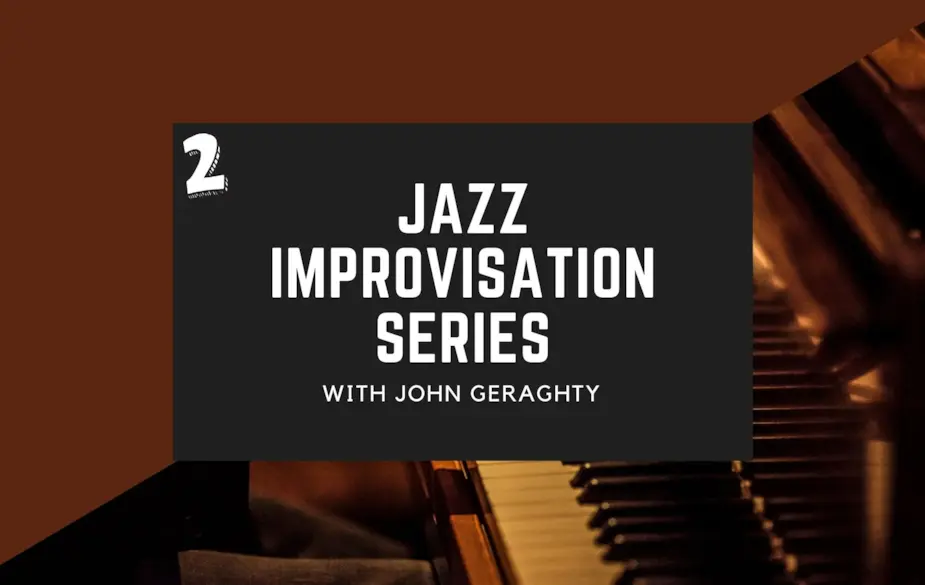Musician and teacher John Geraghty presents part two of his six-part series on Jazz Improvisation
If you’re a classically trained pianist, or you are used to only playing what is written with no personal interpretation added, ‘swinging’ the notes will often sound very rigid.
There are a number of things you can do to help guide you away from that rigidity.
Step 1: Listen to Jazz records
If you’ve never listened to Jazz music or don’t know where to start, we’d recommend Mr Frank Sinatra. Pick your favourite song of his, then search on YouTube to find other singers and musicians performing the same song. Do this every week with a new song and before you know it, you’ll have a good collection of Jazz favourites.
Alternatively, take a listen to our Best of Jazz playlist below.
Step 2: Learn your twelve major scales
These next set of exercises will train your fingers to ‘swing’ the music.
Exercise 1: Start with the C major scale below and continue learning a new scale each day. We recommend learning your twelve major scales in this order: C, G, D, A, E, B, F#, F, Bb, Eb, Ab, Db. Download our All About Major Scales cheat sheet for just £1.99 if you need to refresh your memory of your scales.
Not only will these scales help with your technique, they’ll also help you with improvisation and theory.

Exercise 2: Place an accent on every second quaver.
Practice tip: Play the accented notes ff and the un-accented notes pp. Later on, you can bring the dynamics back to an even level.

Next, we are going to ‘swing’ the notes.
If you’ve ever read a piece of jazz or blues music, you most probably would have seen one of these signs before:

This is the point in which a lot of piano players perform the above incorrectly. Instead of playing it like the CORRECT way below...

They would play it like this....

Can you hear the difference? Listen to these two recordings if you need some help spotting the difference.
Exercise 3: Listen back to your original recordings from Lesson 1 and see if they sound like you’re ‘swinging’ the notes or playing the notes ‘rigid.’
Exercise 4: Divide each crotchet beat below into triplets, i.e., into threes.
Practice tip: Start by counting out loud in triplets, dividing each metronome click into three counts, with the third count louder than the first and second. Saying the number three louder will help your fingers accent the notes at the right time.

Tension and release
Below shows the chord progression (in its simplest form) used in Audio 1 in Lesson 1. This is known as a 12-bar blues. In your previous recording, if you heard any notes not sounding good, you likely played the wrong note over the wrong chord, making it clash and causing ‘tension’. In order to know how to add ‘tension’ and ‘release’ to the music, you must understand harmony.

Play the following chords with the three notes that make up the chord. These notes should not have any tension when played over their respective chords.

Here’s the C blues scale again, as shown in the first part of this series. Which notes would clash when playing over chords C, F and G?

- Over C should be notes Eb, F, F# and Bb
- Over F should be notes Eb, F#, G and Bb
- Over G should be notes C, Eb, F, F# and Bb
Exercise 5: Listen to your original recording again while following along to the chord progression above. When you hear a note clashing, stop the recording and find out which note it is and which chord it was played over.
How to make your ‘wrong’ notes sound ‘right’
If you want to play notes that are not part of the chord, play these notes on off-beats, then play a chord tone note to release it. (tension-release). For example, if you’re playing note C over chord C, you could play Eb (tension) first and then play the E (release) after it.

A final word...
- Practise your major scales with a ‘swing'
- Study the chord tones from each chord
- Practise tension and release over each chord from a non-chord tone to a chord tone
Suggested listening: Frank Sinatra with Count Basie live at the Sands
Coming up in Part 3...
- Targeting notes
- Using the chromatic scale
- Trains' Coming (an original tune)
Missed out on the first part of this series? You can view it here.
About the author
John Geraghty is a songwriter, music producer, pianist, author, teacher and entrepreneur. Although John is a classically trained pianist, his passion lies in songwriting and music producing. He has studied most genres of music including pop, jazz, gospel, country, and blues piano.
He is the author of Playing By Ear – A Songwriter's Way. His teaching method is simple and direct: "Leave out everything that is not necessary and teach the student what they really want to know."







